At four in the afternoon, students stream into the Starbucks below 1920 Commons. Muffled by orders of cold brews creamed with coconut milk and toffee syrup, “Take Five” croons softly through the speakers on this late February Friday. The weekend slips by and soon, teenagers trudge along the second floor of Fisher–Bennett Hall, where the sticky–sweet melody of “In the Mood” playing through an open office door alleviates Monday’s somber atmosphere. Jazz music—especially in settings teeming with life such as a university campus—often does not beg to be listened to. It instead fills the cracks where silence doesn't suffice and other genres do not fit. However, the space it once inhabited was vast.
In a musical canon saturated with “yuh's" from Ariana Grande and neon–colored EDM melodies, what once was America’s idea of cultured fun has changed drastically. Nightclubs booming with bossa novas and big band charts occupied weekends now filled with basement–party pop songs. Records etched with the sound waves of Billie Holiday’s heartfelt ballads have been overtaken by streams of Billie Eilish. This raises the question of how today’s generation allowed jazz to slip out of popular culture. In short: Where did jazz go?
According to Erik Broess, a second–year graduate student at Penn’s Music Department, it has not disappeared; we just have to look closer. He teaches Jazz: Style and History and often brings up in class discussions the question of the genre’s disappearance: “Historically, as jazz has progressed each generation, it becomes more and more stratified and spread out. The closest that you would come to a core in jazz is its origins in New Orleans in the 1910s—as soon as you move past that, you start to have diverse styles popping up and people playing different music under the category of jazz.” This idea of a genre being an umbrella term is more aligned with music as an art form than we recognize. Artists do not—and probably should not—create music to adhere to one specific genre. It is the overlap of styles that characterizes an artist, in a manner similar to the way we characterize our music tastes with varying playlists and favorites.
Jazz has done the same; it has evolved and permeated various areas in a way almost unrecognizable. “Whatever constellation of factors, whether it’s an approach or style that we consider jazz, I think that will exist whether or not it's called jazz,” says Broess. He goes on to mention Esperanza Spalding, a Grammy–winning artist who NPR deemed a modern jazz genius. A lot of praise she receives is for her innovation—from bringing bass into popular music to her intimately heartfelt lyricism. One who is well–versed in jazz’s history would recognize that a lot of inspiration behind her discography is attached to a strand leading straight into New Orleans. Her sound itself, however, does not call listeners back to the floors of the Cotton Club or reminisce the rhythms of Buddy Rich. It is her innovation itself which grants her a home in the niche of jazz icons.
In terms of jazz’s image today in popular culture, Broess believes it has evolved dramatically across history. In the early to mid–twentieth century, part of its immediate boom in popularity was because Americans claimed the genre as their most unadulterated art amidst the constant pressure for patriotism. As it has developed and been incorporated into other genres such as hip–hop and R&B, the need for conservation becomes apparent.
"Pure jazz"—the sector associated with the crystallized Swing Era and legends such as Frank Sinatra—has acquired an elitist, highbrow image. Authoritarians of this trope believe only those who are well–versed in its history and highlights can truly claim the genre. “That barrier to entry is, I think, sort of artificial and constructed through this idea that jazz is high art form that necessitates some cerebral connection and some intellectual invasion before you can actually get it," says Broess, "when really, if people just took it for what it was and engaged with it as an aesthetic art form, they’d be able to appreciate it—whatever that means."
Elitism in jazz has spurred the idea that “jazz is dying,” a conversation dissected in Damien Chazelle's 2016 hit La La Land. Many do not realize that perpetuating this notion is detrimental, and is pushing the genre out of relevancy more than ever. Just because jazz continues to survive through musicians and coffee–shop music connoisseurs doesn’t mean others cannot, and should not, engage with it.
So, is jazz disappearing? The short answer is no—we just aren't looking hard enough. Go out there and give the genre a try, either by visiting one of Penn’s premiere performances (such as those of Penn Jazz Combos), skipping the next party to check out one of Philadelphia’s best jazz joints, or even just streaming artists like Snarky Puppy or Ella Fitzgerald on Spotify. Broess and other professors teach us that jazz was the past. Ryan Gosling preaches in La La Land that jazz is the future. But we must also realize that jazz is the present, and play it louder than ever.

